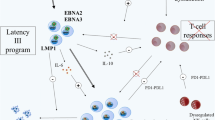Abstract
Posttransplant lymphoproliferative disorder (PTLD) after allogeneic hematopoietic cell transplantation (HCT) is usually donor derived, associated with Epstein–Barr virus (EBV), and of B-cell origin. T-cell PTLD (T-PTLD) after allogeneic HCT is extremely rare. Four of 1015 (0.39%) allogeneic HCT patients were diagnosed with T-PTLD; peripheral T-cell lymphoma-not otherwise specified, anaplastic large cell lymphoma, monomorphic T-cell PTLD and polymorphic PTLD with chronic active EBV infection-like symptoms. Three of the four patients developed T-PTLD within 6 months after HCT from HLA-mismatched unrelated donor. Three (75%) and 4 (100%) cases were positive for EBV-encoded small RNA in situ hybridization and EBV-DNA load in peripheral blood, respectively. Chimerism analysis showed that 75% of T-PTLD tissues (3/4) were recipient derived. T-PTLD was refractory to salvage chemotherapy and fatal in all four patients. Including the 10 patients in the literature, the median interval from HCT to diagnosis of T-PTLD was 5 months (range 1–72 months), 55% were negative for EBV, and 56% were recipient-derived. T-PTLD, which often occurred early after allogeneic HCT, was more likely to be EBV negative and recipient derived than B-cell PTLD after allogeneic HCT. Like T-PTLD after solid organ transplant, T-PTLD after allogeneic HCT demonstrated morphological heterogeneity and poor prognosis.


Similar content being viewed by others
References
Zutter MM, Martin PJ, Sale GE, et al. Epstein–Barr virus lymphoproliferation after bone marrow transplantation. Blood. 1988;72:520–9.
Landgren O, Gilbert ES, Rizzo JD, Socie G, Banks PM, Sobocinski KA, et al. Risk factors for lymphoproliferative disorders after allogeneic hematopoietic cell transplantation. Blood. 2009;113:4992–5001.
Styczynski J, Gil L, Tridello G, Ljungman P, Donnelly JP, van der Velden W, et al. Response to rituximab-based therapy and risk factor analysis in Epstein Barr virus-related lymphoproliferative disorder after hematopoietic stem cell transplant in children and adults: a study from the Infectious Diseases Working Party of the European Group for Blood and Marrow Transplantation. Clin Infect Dis. 2013;57:794–802.
Dierickx D, Habermann TM. Post-transplantation lymphoproliferative disorders in adults. N Engl J Med. 2018;378:549–62.
Fujimoto A, Hiramoto N, Yamasaki S, Inamoto Y, Uchida N, Maeda T, et al. Risk factors and predictive scoring system for post-transplantation lymphoproliferative disorder after hematopoietic stem cell transplantation. Biol Blood Marrow Transplant. 2019;25:1441–9.
Herreman A, Dierickx D, Morscio J, Camps J, Bittoun E, Verhoef G, et al. Clinicopathological characteristics of posttransplant lymphoproliferative disorders of T-cell origin: single-center series of nine cases and meta-analysis of 147 reported cases. Leuk Lymphoma. 2013;54:2190–9.
Tiede C, Maecker-Kolhoff B, Klein C, Kreipe H, Hussein K. Risk factors and prognosis in T-cell posttransplantation lymphoproliferative diseases: reevaluation of 163 cases. Transplantation. 2013;95:479–88.
Swerdlow SH, Campo E, Harris NL, Jaffe ES, Pileri SA, Stein H, et al., editors. WHO classification of tumours of haematopoietic and lymphoid tissues. 4th ed. Lyon: IARC Press; 2017.
Zutter MM, Durnam DM, Hackman RC, Loughran TP Jr, Kidd PG, Ashley RL, et al. Secondary T-cell lymphoproliferation after marrow transplantation. Am J Clin Pathol. 1990;94:714–21.
Wang LC, Lu MY, Yu J, Jou ST, Chiang IP, Lin KH, et al. T cell lymphoproliferative disorder following bone marrow transplantation for severe aplastic anemia. Bone Marrow Transplant. 2000;26:893–7.
Au WY, Lam CC, Lie AK, Pang A, Kwong YL. T-cell large granular lymphocyte leukemia of donor origin after allogeneic bone marrow transplantation. Am J Clin Pathol. 2003;120:626–30.
Chang H, Kamel-Reid S, Hussain N, Lipton J, Messner HA. T-cell large granular lymphocytic leukemia of donor origin occurring after allogeneic bone marrow transplantation for B-cell lymphoproliferative disorders. Am J Clin Pathol. 2005;123:196–9.
Santos-Briz A, Romo A, Antunez P, Roman C, Alcoceba M, Garcia JL, et al. Primary cutaneous T-cell lymphoproliferative disorder of donor origin after allogeneic haematopoietic stem-cell transplantation. Clin Exp Dermatol. 2009;34:e778–e781.
Nishida A, Yamamoto H, Ohta Y, Karasawa M, Kato D, Uchida N, et al. T-cell post-transplant lymphoproliferative disorder in a patient with chronic idiopathic myelofibrosis following allogeneic PBSC transplantation. Bone Marrow Transplant. 2010;45:1372–4.
Tanaka T, Takizawa J, Miyakoshi S, Kozakai T, Fuse K, Shibasaki Y, et al. Manifestations of fulminant CD8 T-cell post-transplant lymphoproliferative disorder following the administration of rituximab for lymphadenopathy with a high level of Epstein–Barr Virus (EBV) replication after allogeneic hematopoietic stem cell transplantation. Intern Med. 2014;53:2115–9.
Acknowledgements
This work was supported by a Grant from the National Cancer Center Research and Development Fund (29-A-14).
Author information
Authors and Affiliations
Corresponding author
Ethics declarations
Conflict of interest
The authors declare that they have no conflict of interest.
Additional information
Publisher's Note
Springer Nature remains neutral with regard to jurisdictional claims in published maps and institutional affiliations.
About this article
Cite this article
Kuno, M., Ito, A., Maeshima, A.M. et al. T-cell posttransplant lymphoproliferative disorders after allogeneic hematopoietic cell transplantation. Int J Hematol 112, 193–199 (2020). https://doi.org/10.1007/s12185-020-02890-1
Received:
Revised:
Accepted:
Published:
Issue Date:
DOI: https://doi.org/10.1007/s12185-020-02890-1




